What is so good about the Beef Pink Brandy f1 tomato and why summer residents love it so much: an overview of the variety and the secrets of growing it
Beef tomatoes are large multi-chambered fruits grown indoors. The high sucrose content makes them sweet and tasty. Tall hybrids produce large yields and are immune to bacterial and viral infections. In this material, we have prepared for you information about Beef Pink Brandy F1 tomatoes: characteristics and description of the crop, features of agricultural technology in greenhouse conditions.
Description of the hybrid
Mid-season Beef Pink Brandy F1 was bred by Dutch breeders in 2001. Suitable for cultivation in greenhouses and greenhouses. It was highly appreciated by gardeners due to its unpretentiousness in care, beautiful even shade of fruit and wonderful delicate taste.
The tomato is endowed with these features:
- indeterminate bushes grow up to 2 m in height;
- the first fruits ripen 75–80 days after planting in the ground or 110–120 days after sowing;
- ripening occurs unevenly;
- internodes shortened;
- in film-type greenhouses the plant forms 6-7 clusters;
- resistant to leaf spot, verticillium, fusarium, tobacco mosaic virus (TMV).
The photo shows the hybrid Beef Pink Brandy F1.
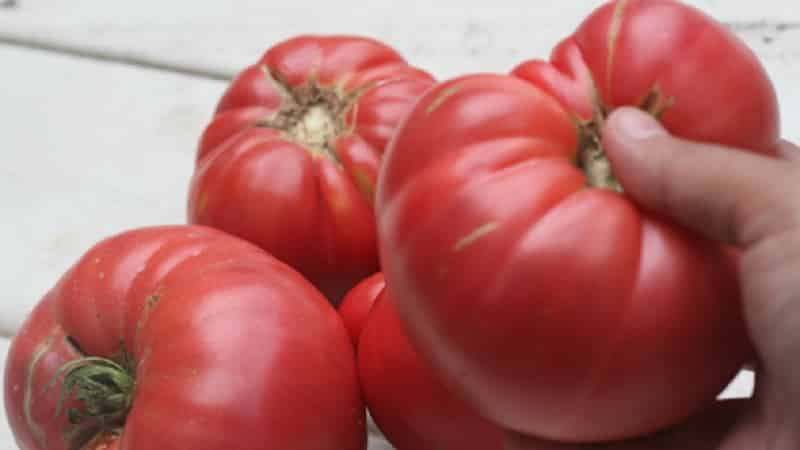
Fruit characteristics and yield
Tomatoes have a number of features:
- ripe fruits of rich pink-raspberry color;
- high content of sucrose and carotene;
- the shape is flat-round, ribbed, with a small spout;
- the weight of the fruit varies on average from 250 to 400 g;
- the skin is thin, but does not crack;
- the pulp is juicy, sweet, with slight sourness, medium density;
- 6 seed chambers with a large number of seeds;
- shelf life reaches 25 days;
- suitable for fresh consumption;
- attractive appearance.
The hybrid yield is high: up to 25 kg are collected from 1 m² (or 5–7 kg per bush).
Reference. The record weight of the Beef Pink Brandy tomato is 1 kg.
Growing seedlings
Tomatoes are grown in seedlings in a light but nutritious substrate with mandatory picking into separate containers.
Seed preparation
Seed material is disinfected in production, so this is not necessary at home. The special composition already protects future seedlings from nightshade diseases: bronzing virus, TMV, root-knot nematodes.
Container and soil
Use any container for sowing seeds (pots, plastic containers, tetrapacks) and light substrate from gardening stores. If desired, you can prepare it yourself from chernozem, peat, humus, ash and superphosphate. The soil is pre-steamed, heated in the oven or watered with a solution of potassium permanganate. Large fractions, pebbles and debris are removed.
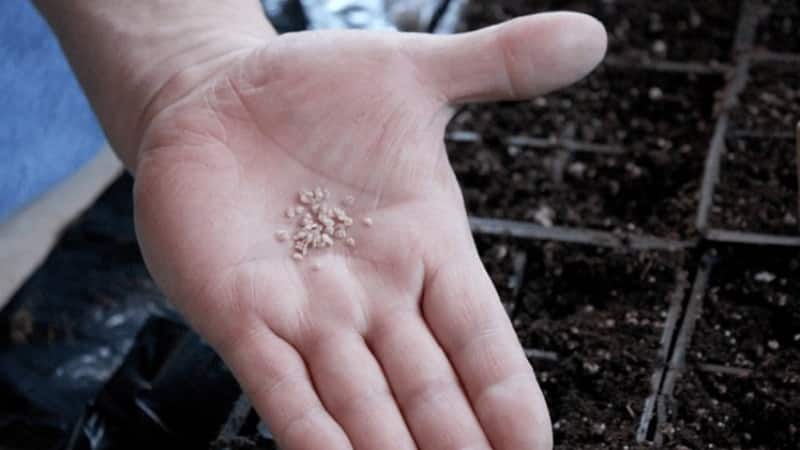
Sowing
Sowing is carried out in the first half of March 60–65 days before transplanting into the ground. Furrows 2 cm deep are formed in the soil and the material is planted at intervals of 2 cm. A layer of soil (0.5 mm) is poured on top and the containers are covered with film, which is removed daily for ventilation. The container is placed in a dark place. Shoots appear at a stable air temperature of +18…+21 °C.
Growing and care
After the sprouts appear, the containers are transferred to a windowsill with sufficient lighting.. Picking is carried out after the formation of 3 leaves in individual peat or plastic cups. This will help strengthen the root system.
Young seedlings are watered once every 2 days. Reduce moisture up to 3 times every 7 days during the growing season.
Tomato cultivation
Beef Pink Brandy F1 grows best in fertile light soil with neutral pH=7. The plant needs staking and formation into one stem.
The culture adapts to any climatic conditions. In the northern regions, greenhouses are additionally heated and lit. In the southern corners of the country, it is permissible to grow tomatoes in open ground if there is no risk of night frosts, but the yield is greatly reduced.
Since the hybrid was originally bred for cultivation in greenhouses, we will tell you more about this method.
Read about other varieties:
How to grow Black Elephant tomato
Advantages and disadvantages of the Raspberry Elephant variety
Landing
A place for tomatoes is chosen on the sunny side or additional lighting sources are installed in the greenhouse.
Planting in the ground begins from May 15 to June 5 (40–50 days after sowing). The gap between seedlings is 50–60 cm. Dig holes 10 cm deep and water with a strong solution of potassium permanganate or boiling water to disinfect the soil.

Care
Hybrid Beef Pink Brandy F1 is low maintenance, but, like any other plant, it needs watering, loosening the soil, fertilizing, and removing weeds.
The main rule of proper hydration is moderation.. Water in the beds should not stagnate, otherwise the tomatoes will become watery and tasteless. Water with settled warm water strictly at the root. The soil is then loosened.
Advice. If possible, organize drip irrigation of the crop. This way the earth will be constantly moistened and will not be afraid of any drought.
Before ovaries form plants are fertilized with nitrogen, then switch to potassium-phosphorus mixtures.
Recipes for the best fertilizers for tomatoes per 10 liters:
- 500 ml liquid mullein, 1 tbsp. l. nitrophoska;
- 500 ml chicken manure, 1 tbsp. l. superphosphate, 1 tsp. potassium sulfate;
- 1 tbsp. l. potassium humate, 1 tbsp. l. nitrophoska.
Spraying boric acid prevents flowers and ovaries from falling off. It is enough to treat the tomatoes twice with this solution in the proportion of 1 g of dry matter per 1 liter of clean water to solve the problem.
Features of cultivation
Rules for forming bushes:
- Indeterminate plants are planted, remove excess side shoots and form them into one stem. The seed manufacturer claims that this way it will be possible to achieve high yields. Side shoots are removed 14 days after planting the seedlings, then broken off every day when they reach a length of 5–7 cm.
- The growth of bushes is limited after 6-7 brushes by pinching; 2 leaves are left above the top brush.
- Removing the lower leaves with a frequency of 1-2 times a week begins after the fruits of the first cluster reach a diameter of 4-5 cm.
- The bushes are tied up to protect them from bending under the weight of the tomatoes.
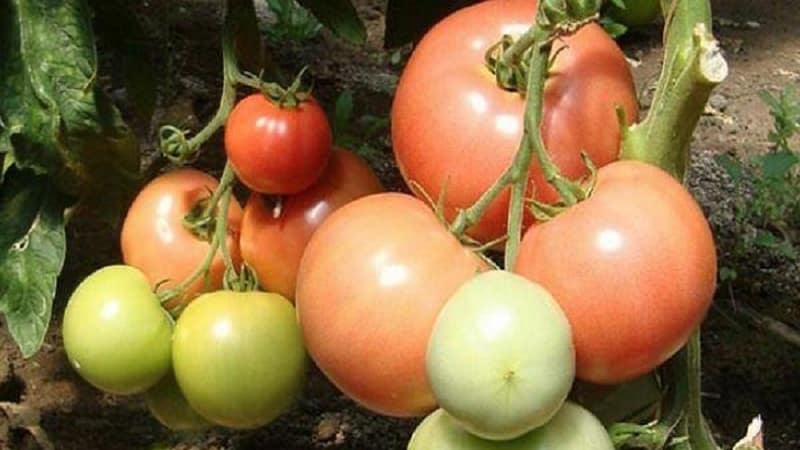
The hybrid needs additional pollination when grown indoors. To do this, a beehive is installed in a greenhouse during the period of ovary formation and removed after harvesting the fruits. If tomatoes are grown in a greenhouse during the warm season, hives do not need to be installed. It is enough to keep the windows open for free access of bees.
The bushes are periodically shaken with light movementsto prevent pollen from shedding quickly, otherwise pollination will not occur.The manipulation is carried out three times a week. The appearance of ovaries indicates the success of the work done.
The temperature in the greenhouse should not fall below +15 °C, otherwise deformation of the anthers will occur. At air temperatures above +30 °C, pollen viability decreases, and at +35 °C, the anthers become sterile.
It is important to maintain the humidity level no higher than 70%, otherwise the pollen sticks together and loses its ability to scatter throughout the plants.
Disease Prevention
The hybrid is immune to leaf spot, verticillium, fusarium, tobacco mosaic virus at the genetic level.
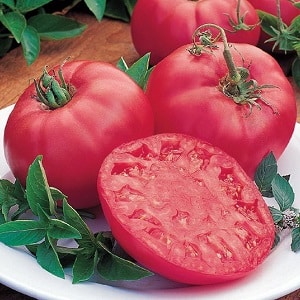 If watering rules are not followed, high humidity in the greenhouse, and an excess of nitrogen, plants are affected by late blight. The disease can be recognized by its characteristic signs: brown spots, white fluffy coating on the leaves and stems, and deformation of the fruit. The best way to prevent infection is prevention:
If watering rules are not followed, high humidity in the greenhouse, and an excess of nitrogen, plants are affected by late blight. The disease can be recognized by its characteristic signs: brown spots, white fluffy coating on the leaves and stems, and deformation of the fruit. The best way to prevent infection is prevention:
- disinfection of greenhouses with sulfur bombs in the fall;
- steaming the soil with boiling water or treating it with chemicals;
- mulching the soil with sawdust, peat, pine needles;
- maintaining optimal humidity levels.
- renewal of the top layer of soil (5 cm).
If infection cannot be avoided, they treat the bushes with the following preparations: “Acrobat”, “Barrier”, "Fitosporin". Irrigation is stopped 3 weeks before harvesting the fruits.
Insect control
At the beginning of July, aphids and spider mites become active and must be combated folk remedies for spraying bushes help:
- Garlic infusion. Take 300 g of crushed raw materials per 1 liter of water and leave for 5 days. Treat 3-4 times with an interval of 3 days.
- Wood ash. For 10 g of water take 50 g of ash, 50 ml of soap, mix and filter. Use constantly, 2 times a month.
- Tobacco. Take 400 g of shag for 10 liters of boiling water and leave to brew for 2 days. Irrigate at least three times every 3 days.
- Onion peel. Take 50 g of raw material per 3 liters of warm water and soak for 6–8 hours, then add 10 ml of liquid soap and mix. Treat 2 times with an interval of 5 days.
From whitefly The drugs “Aktara” and “Fitoverm” are saving the day. The manufacturer indicates the dosage and frequency of treatment on the packaging.
Harvesting and application
Tomatoes are harvested between July and September. Pink fruits are versatile in cooking and are suitable for preparing salads, vegetable cuts, soups, sauces, juice, pasta, stuffing and canning in pieces.
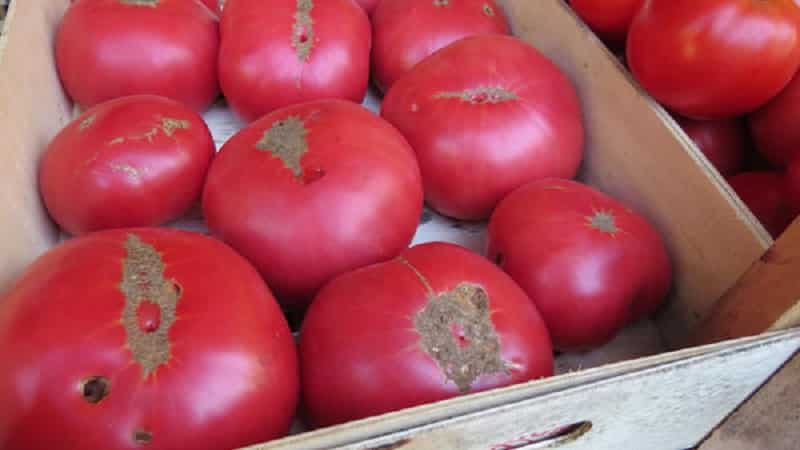
Advantages and disadvantages
Advantages of the hybrid Beef Pink Brandy:
- high productivity;
- large fruit sizes;
- excellent taste;
- long shelf life;
- uneven ripening allows you to enjoy the fruits for a long time;
- resistance to viruses and bacteria.
Disadvantages of culture include the difficulty of growing indoors and the need for pinching and tying up bushes.
Reviews
Feedback from farmers about Beef Pink Brandy is extremely positive:
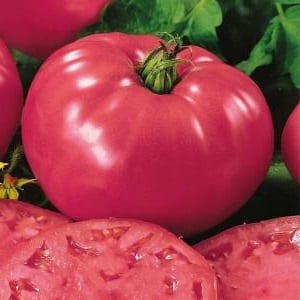 Miroslav, Satka: “I grow tomatoes for sale, so I give preference to hybrids. They do not need special care, rarely get sick, and produce large harvests. One of my favorites is Beef Pink Brandy. The tomatoes grow large, juicy and sweet.”.
Miroslav, Satka: “I grow tomatoes for sale, so I give preference to hybrids. They do not need special care, rarely get sick, and produce large harvests. One of my favorites is Beef Pink Brandy. The tomatoes grow large, juicy and sweet.”.
Alla, Varna: “I have been growing these tomatoes for 5 years in a row in a polycarbonate greenhouse. There are minor difficulties with pollination, which can be solved by installing a hive with bees. The culture is practically not sick with anything. Sometimes you have to treat bushes for aphids, but stores offer a large selection of products that quickly solve the problem.”.
Ivan, Roslavl: “Beef Pink Brandy is one of the best Dutch hybrids. It is distinguished by long-term fruiting and disease resistance. In order to consistently obtain a high yield, it is important to maintain an optimal microclimate in the greenhouse, water it on time and fertilize it with potassium and phosphorus.”.
Conclusion
Beef Pink Brandy is an ideal hybrid for growing in greenhouse conditions. The crop has genetic immunity to bronzing and tomato mosaic viruses, root-knot nematodes, fusarium and verticillium. Minor difficulties with pollination can be solved by installing hives in greenhouses or by constantly opening the windows during the summer season. Pleasant sweet taste, high yield (5–7 kg per bush), delicate but strong skin and excellent shelf life (up to 25 days) - all these qualities allow tomatoes to remain at the peak of popularity.